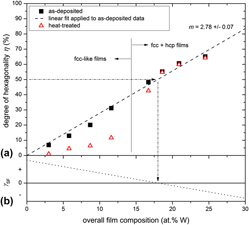Crossref Citations
This article has been cited by the following publications. This list is generated based on data provided by
Crossref.
Csiszár, G.
Kurz, S.J.B.
and
Mittemeijer, E.J.
2016.
Stability of nanosized alloy thin films: Faulting and phase separation in metastable Ni/Cu/Ag-W films.
Acta Materialia,
Vol. 110,
Issue. ,
p.
324.
Flötotto, D.
Wang, Z. M.
Markel, I. J.
Kurz, S. J. B.
and
Mittemeijer, E. J.
2016.
Microstructure and intrinsic stress evolution during epitaxial film growth of an Ag0.93Al0.07 solid solution on Si(111); excessive planar faulting due to quantum confinement.
Journal of Applied Physics,
Vol. 120,
Issue. 15,
O’Brien, C. J.
Barr, C. M.
Price, P. M.
Hattar, K.
and
Foiles, S. M.
2018.
Grain boundary phase transformations in PtAu and relevance to thermal stabilization of bulk nanocrystalline metals.
Journal of Materials Science,
Vol. 53,
Issue. 4,
p.
2911.
Langer, G.A.
Erdélyi, G.
Erdélyi, Z.
and
Csiszár, G.
2019.
Determination of diffusion coefficients in immiscible systems: Cu W as an example.
Materialia,
Vol. 6,
Issue. ,
p.
100342.
Allahyarzadeh, M.H.
Aliofkhazraei, M.
Rouhaghdam, A. Sabour
Alimadadi, H.
and
Torabinejad, V.
2020.
Mechanical properties and load bearing capability of nanocrystalline nickel-tungsten multilayered coatings.
Surface and Coatings Technology,
Vol. 386,
Issue. ,
p.
125472.
Valentino, Gianna M.
Xiang, Sisi
Ma, Luoning
Xie, Kelvin Y.
He, Mo-Rigen
Oliver, Warren C.
Pharr, George M.
Krogstad, Jessica A.
Weihs, Timothy P.
and
Hemker, Kevin J.
2021.
Investigating the compressive strength and strain localization of nanotwinned nickel alloys.
Acta Materialia,
Vol. 204,
Issue. ,
p.
116507.
Shi, Xinyang
Zhang, Zhongquan
Dai, Leyu
Lv, Yin
Xu, Zhao
Yin, Yibiao
Liao, Zhiqun
and
Wei, Guoying
2022.
Effect of Al2O3 Nanoparticles and Heat Treatment on the Wear Resistance of Electrodeposited Ni-W/Al2O3 Composite Coatings.
Journal of Materials Engineering and Performance,
Vol. 31,
Issue. 4,
p.
3094.
Li, Qizhen
2022.
Study of growth twins produced through heat treatment of fine-grained magnesium.
Materials Science and Engineering: A,
Vol. 841,
Issue. ,
p.
143047.
Kalchev, Y.
Zehl, R.
Piotrowiak, T.
Kostka, A.
Naujoks, D.
Pfetzing-Micklich, J.
and
Ludwig, A.
2023.
Microstructure and Mechanical Properties of a Ni-Based Superalloy Thin Film Investigated by Micropillar Compression.
Metallurgical and Materials Transactions A,
Vol. 54,
Issue. 5,
p.
1526.
Gao, Yipeng
Kong, Cheng
Du, Chunfeng
Ding, Jiyuan
Li, Haipeng
Song, Yuchao
Liang, Heng-Nan
and
Wang, Hui-Yuan
2024.
Grain boundary engineering using self-organized high-index twins produced by twin-twin reactions in β-Ti alloys: A phase field study.
Journal of Materials Research and Technology,
Vol. 30,
Issue. ,
p.
733.
Nenninger, Tara
and
Sansoz, Frederic
2025.
Solute clustering in polycrystals: Unveiling the interplay of grain boundary junction and long-range solute attraction effects.
Acta Materialia,
Vol. 290,
Issue. ,
p.
120946.
Alwen, A.
Peter, Nicolas J.
Schwaiger, Ruth
and
Hodge, A. M.
2025.
Study of growth twins and phase formation in CuNiAl alloys via a combinatorial approach.
Journal of Materials Research,
Vol. 40,
Issue. 2,
p.
202.



